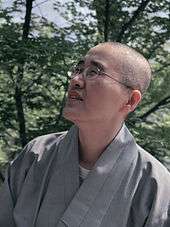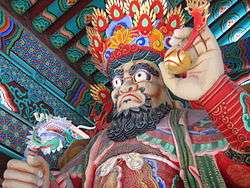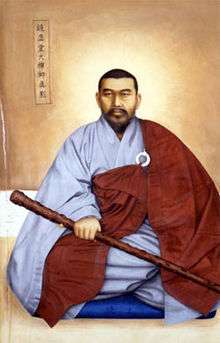Korean Seon
Seon or Sŏn Buddhism (Korean: 선, 禪; IPA: [sʌn]) is the Korean name for Chan Buddhism, a branch of Mahāyāna Buddhism commonly known in English as Zen Buddhism. Seon is the Sino-Korean pronunciation of Chan (Chinese: 禪; pinyin: chán) an abbreviation of 禪那 (chánnà), which is a Chinese transliteration of the Sanskrit word of dhyāna ("meditation"). Seon Buddhism, represented chiefly by the Jogye and Taego orders, is the most common type of Buddhism found in Korea.
.jpg)
| Part of a series on |
| Zen Buddhism |
|---|
 |
|
Persons Chán in China Classical
Contemporary
Zen in Japan Seon in Korea Thiền in Vietnam Zen / Chán in the USA Category: Zen Buddhists |
|
Doctrines
|
|
Awakening |
|
Practice |
|
Schools
|
|
Related schools |
| Part of a series on |
| Buddhism |
|---|
 |
|
|
|
A main characteristic of Seon Buddhism is the use of the method of meditation, Ganhwa Seon (Korean: 간화선/看話禪). A Korean monk, Jinul (Korean: 지눌/知訥) accepted partially a meditative method of Chan Buddhism in 1205. In Chan Buddhism, hwadu (Korean: 화두/話頭) is a delivery of realising a natural state of the Awakening. Jinul addressed a doctrine of Sagyo Yiepseon (Korean: 사교입선/捨敎入禪) that monks should live an inborn life after learning and forgetting all creeds and theories. Within the doctrine of Jinul, hwadu is the witnessing of truthful meaning in everyday life.[1]
History of Seon
During the Goryeo dynasty Jinul strongly influenced Korean Buddhism. He was the first monk to be appointed a national teacher and advisor by the king, having written a book presenting the Seon tradition from the Song dynasty.[2] And this Seon tradition preserved well to this day, after Taego Bou brought his Dharma transmission to Goryeo.[3]
The Joseon dynasty suppressed Buddhism in favour of confucianism. In spite of the suppression, Hyujeong wrote about the three religions (Seon Buddhism, Confucianism, Taoism) in the Joseon dynasty from Seon point of view. He also succeeded to the Dharma transmission. During the Japanese invasions of Korea (1592–98), Hyujeong and Yujeong commanded guerrilla units of monks and took part in diplomacy. [4]
Under annexation by Japan most monks were forced to marry - this lasted about 40 years until the act of purification. [5]During those times, masters like Gyoengheo and Mangong kept Dharma transmission alive.
21th century, the few left this Dharma transmission. "남진제 북송담'(南眞際 北松潭) (Jinje to the south, Songdam to the north)."[6] is well-known phrase in Korean seon tradition these days. Others are Seungsahn, Daewon.

Unified Silla Period (668–935)
Transmission of Chan to Korea
Chan was transmitted into Unified Silla (668-935).[7][8][web 1] Beomnang (法朗, Pŏmnang, Peomnang) (632-646), who studied with the Fourth Patriarch Dayi Daoxin (道信) (580-651), was the first to bring the teachings to Korea.[7][8] Beomnang transmitted his teachings to Sinhaeng (神行) (704-779), who also traveled to China. Sinhaeng studied with Puji (651–739), a successor of Yuquan Shenxiu (died 706), the head of the East Mountain Teaching of Chan.[8] Seon was further popularized by Doui (道義) (died 825) at the beginning of the ninth century.
Nine Schools
Seon was gradually further transmitted into Korea, as Korean monks of predominantly Hwaeom (華嚴) and Yogacara (唯識) background began to travel to China to study the Hongzhou school of Mazu Daoyi (709–788) and his successors[8] and the Rinzai school of Linji Yixuan. Mazu's successors had numerous Korean students, some of whom returned to Korea and established their own schools at various mountain monasteries with their leading disciples.[8]
Initially, the number of these schools was fixed at nine. Seon was termed the nine mountain schools" at the time.[7] Eight of these were of the lineage of Mazu Daoyi (馬祖道一) (709-788), as they were established through connection with either him or one of his eminent disciples.[8] The one exception was the Sumi-san school founded by Yieom (利嚴) (869-936), which had developed from the Caodong school (曹洞).
Toǔi (道義 Doui) (died 825), who studied with Zhizang (735-814) and Baizhang Huaihai (百丈) (749-814) is regarded as the first patriarch of Korean Sŏn. He founded the Kaji Mountain school (迦智山 Gaji san school). The Nine mountain Schools adopted the name Jogye Order in 826. The first record of the Nine Mountains school dates from 1084.[8]
Goryeo Dynasty (918–1392)
Tension
By the eleventh century Sŏn Buddhism became established in Korea. It distinguished itself from the existing Five Schools[note 1] and their scriptural emphasis.[8] Tension developed between the new meditational schools and the previously existing scholastic schools, which were described by the term gyo, meaning "learning" or "study". Efforts were needed to attain mutual understanding and rapprochement between Sŏn and these scholastic schools.[8]
Jinul
The most important figure of Goryeo-era Seon was Jinul (Korean: 지눌; Hanja: 知訥, 1158-1210), who established a reform movement in Korea. In his time, the sangha was in a crisis of external appearance and internal issues of doctrine. Buddhism was seen as infected by secular tendencies and involvements, such as fortune-telling and the offering of prayers and rituals for success in secular endeavors. This perceived corruption was seen to create a profusion of monks and nuns with questionable motives. Therefore, the correction, revival, and improvement of the quality of Buddhism were prominent issues for Buddhist leaders of the period.
Jinul sought to establish a new movement within Korean Seon, which he called the "samādhi and prajñā society". Its goal was to establish a new community of disciplined, pure-minded practitioners deep in the mountains. He eventually accomplished this mission with the founding of the Songgwangsa (松廣寺) at Jogyesan as a new center of pure practice.
Jinul's works are characterized by a thorough analysis and reformulation of the methodologies of Seon study and practice. He laid an equal emphasis on doctrinal teaching and Sŏn practice.[8] One major issue that had long fermented in Chan, and which received special focus from Jinul, was the relationship between "gradual" and "sudden" methods in practice and enlightenment. Drawing upon various Chinese treatments of this topic, most importantly those by Guifeng Zongmi (780-841) and Dahui Zonggao (大慧宗杲) (1089–1163), Jinul created Pojo Sŏn,[8] a "sudden enlightenment followed by gradual practice" dictum, which he outlined in a few relatively concise and accessible texts.[9] Jinul incorporated Dahui Zonggao's gwanhwa (Chinese: 觀話; pinyin: guān huà, "observing the critical phrase") into his practice.[10] This form of meditation is the main method taught in Korean Seon today.[11]
Jinul's philosophical resolution of the Seon-Gyo conflict brought a deep and lasting effect on Korean Buddhism.
Hyesim
Jinul’s successor, Chin’gak Hyesim (혜심/慧諶: 1178~1234) further emphasized the hwadu (Ch. huatou, "word head" or "critical phrase") practice. He collected 1,125 gongans in his Sŏnmun yŏmsongjip ("The Collection of Verses and Cases", 1226). Hyesim encouraged female practitioners to practice hwadu, where-as women’s Buddhist practice was limited to chanting and sūtra-readings.[8]
Jogye Order
It was during the time of Jinul that the Jogye Order, a Seon sect, became the predominant form of Korean Buddhism, a status it still holds. Taego Bou (1301–1382) studied the Linji school in China and returned to unite the Nine Mountain Schools.
There would be a series of important Seon teachers during the next several centuries, such as Hyegeun (Korean: 혜근; Hanja: 慧勤, 1320-76), Taego Bou (1301–82), Gihwa (1376–1433) and Hyujeong (1520-1604), who continued to develop the basic mold of Korean meditational Buddhism established by Jinul.
Joseon (1392-1897)
Suppression
At the end of Goryeo and during Joseon the Jogye Order was combined with the scholarly schools. It lost influence under the ruling class, which embraced neo-Confucianism.[web 2] Buddhism was gradually suppressed for the next 500 years. The number of temples was reduced, restrictions on membership in the sangha were installed, and Buddhist monks and nuns were literally chased into the mountains, forbidden to mix with society. Joseon Buddhism was first condensed to Seon and Gyo. Eventually, these were further reduced to the single school of Seon.
Giwha wrote an important treatise in defense of Buddhism, the Hyeonjeong non. In the tradition of earlier philosophers, he applied Essence-Function and Hwaeom (sa-sa mu-ae, "mutual interpenetration of phenomena").[web 2]
During Joseon, the number of Buddhist monasteries dropped from several hundred to a mere thirty-six. Limits were placed on the number of clergy, land area, and ages for entering the sangha. When the final restrictions were in place, monks and nuns were prohibited from entering the cities. Buddhist funerals, and even begging, were outlawed. A few rulers temporarily lifted the more suppressive regulations. The most noteworthy of these was the Queen Munjeong. The queen had deep respect for the brilliant monk Bou (보우, 普雨; 1515–1565), and installed him as the head of the Seon school.
Seosan
Buddhist monks helped in repelling the Japanese invasions of Korea (1592–98). Monks were organized into guerrilla units, which enjoyed some instrumental successes. The "righteous monk" (義士; uisa) movement was led by Hyujeong (1520–1604), a Seon master and the author of a number of important religious texts. The presence of the monks' army was a critical factor in the eventual expulsion of the Japanese invaders.
Seosan made efforts toward the unification of Buddhist doctrinal study and practice. He was strongly influenced by Wonhyo, Jinul, and Giwha. He is considered the central figure in the revival of Joseon Buddhism, and most major streams of modern Korean Seon trace their lineages back to him through one of his four main disciples: Yujeong (1544–1610); Eongi (1581–1644), Taeneung (1562–1649) and Ilseon (1533–1608), all four of whom were lieutenants to Seosan during the war with Japan.

Late Joseon Kingdom
Buddhism during the three centuries, from the time of Seosan down to the next Japanese incursion into Korea in the late nineteenth century, did not change very much. The Buddhism of the late Joseon Kingdom saw a revival of Hwaeom studies. There was also a revival of Pure Land Buddhism.
Korean Empire (1897-1910) and Japanese annexation (1910-1945)
With the Korean Empire started the Gwangmu Reform, a modernisation of Korea. The Korean Empire ended in 1910, when Korea was annexated by Japan.
Korean monks travelled to Japan for the scholarly study of Buddhism, where they were influenced by Japanese scholars who introduced western ideas into their studies. Via those Korean monks western ideas were also introduced in Korean Buddhism, and a bifurcation developed between monks and scholars.[web 3]
Division of Korea (1945-present)
After the Second World War the United Nations developed plans for a trusteeship administration, the Soviet Union administering the peninsula north of the 38th parallel and the United States Army Military Government in Korea administering the south. The politics of the Cold War resulted in the 1948 establishment of two separate governments, North Korea and South Korea.
Contemporary Seon
Since the middle of the 20th century Christianity has competed with Buddhism in South Korea,[web 3] while religious practice has been suppressed in North Korea.[web 4]
Seon continues to be practiced in Korea today at a number of major monastic centers, as well as being taught at Dongguk University, which has a major of studies in this religion. The largest Buddhist denomination is the Jogye Order.
In the 1980s a debate arose about "sudden" versus "gradual" enlightenment".[web 3] Since Jinul Korean Seon was based on the integration of practice and scholarly study in the slogan "sudden enlightenment, gradual cultivation". The modern Korean Seon master Seongcheol revived the slogan "sudden enlightenment, sudden cultivation", ascribed to Huineng.[web 5] The last three Supreme Patriarchs of the Jogye Order have a stance in this debate that is in accordance with Seongcheol.
Spread in the United States
Korean Seon has been spread in the US by Seungsahn. He was a temple abbot in Seoul and after living in Hong Kong and Japan, he moved to the US in 1972, not speaking any English. On the flight to Los Angeles, a Korean American passenger offered him a job at a laundry in Providence, Rhode Island, which became headquarters of Seung Sahn's Kwan Um School of Zen. Shortly after arriving in Providence, he attracted students and founded the Providence Zen Center. The Kwan Um School has more than 100 Zen centers on six continents.

Another Korean Zen teacher, Samu Sunim, founded Toronto's Zen Buddhist Temple in 1971. He is head of the Buddhist Society for Compassionate Wisdom, which has temples in Ann Arbor, Chicago, Mexico City, and New York City.
In the early 20th century, Master Kyongho (1849–1912), re-energized Korean Seon. At the end of World War II, his disciple, Master Mann Gong (1871–1946), proclaimed that lineage Dharma should be transmitted worldwide to encourage peace through enlightenment. Consequently, his Dharma successor, Hye Am [web 6] (1884–1985) brought lineage Dharma to the United States. Hye Am's Dharma successor, Myo Vong[12] founded the Western Son Academy (1976), and his Korean disciple, Pohwa Sunim, founded World Zen Fellowship (1994) which includes various Zen centers in the United States, such as the Potomac Zen Sangha, the Patriarchal Zen Society and the Baltimore Zen Center.[web 7]
Notes
- Kyeyul chong (Vinaya school), Yŏlban chong (Nirvāna school), Pŏpsŏng chong (Dharma Nature school), Hwaŏm chong (Huayen school), and Pŏpsang chong (Yogācāra school).[8]
References
Book references
- "실용 한-영 불교용어사전". dic.tvbuddha.org (in Korean). Retrieved 2017-09-06.
- "Jinul > Korean Seon Masters | Welcome to Jogye Order of Korean Buddhism". www.koreanbuddhism.net. Retrieved 2017-09-06.
- "Bou > Korean Seon Masters | Welcome to Jogye Order of Korean Buddhism". www.koreanbuddhism.net. Retrieved 2017-09-06.
- "Hyujeong > Korean Seon Masters | Welcome to Jogye Order of Korean Buddhism". www.koreanbuddhism.net. Retrieved 2017-09-06.
- "한국 전통 간화선풍 되살린 선지식 진면목 - 법보신문" (in Korean). Retrieved 2017-09-06.
- ""송담 스님 잘못 보필한 허물 참회합니다" - 법보신문" (in Korean). Retrieved 2017-09-06.
- Marshall 1995, p. 63.
- Keown & Prebish 2007.
- Buswell 1991a.
- Buswell 1991b.
- Lachs 2012.
- Vong 2008.
Web-references
- Routledge Encyclopedia of Philosophy, "Buddhist philosophy, Korean"
- Routledge Encyclopedia of Philosophy, "11 Chosôn period (1392–1910)" Archived 2013-06-10 at WebCite
- Routledge Encyclopedia of Philosophy, "Conclusion" Archived 2013-06-10 at WebCite
- CIA, North Korea
- Buddhism.org Buddhist eLibrary, "Toeong Seongcheol"
- "Hye-Am". Retrieved 2010-10-10.
- "World Zen Fellowship". Retrieved 2010-10-10.
Sources
- Buswell, Robert E. (1991a), Tracing Back the Radiance: Chinul's Korean Way of Zen, University of Hawaii Press, ISBN 0824814274
- Buswell, Robert E. (1991b), The "Short-cut" Approach of K'an-hua Meditation: The Evolution of a Practical Subitism in Chinese Ch'an Buddhism. In: Peter N. Gregory (editor)(1991), Sudden and Gradual. Approaches to Enlightenment in Chinese Thought, Delhi: Motilal Banarsidass Publishers Private Limited
- Buswell, Robert E. (1993), The Zen Monastic Experience: Buddhist Practice in Contemporary Korea, Princeton University Press
- Buswell, Robert E (1993), Ch'an Hermeneutics: A Korean View. In: Donald S. Lopez, Jr. (ed.)(1993), Buddhist Hermeneutics, Delhi: Motilal Banarsidass
- Keown, Damien; Prebish, Charles S. (2007), Encyclopedia of Buddhism: Sŏn Buddhism (Korean Zen), Routledge
- Kim, Jinwung (2012), A History of Korea: From "Land of the Morning Calm" to States in Conflict, Indiana University Press
- Lachs, Stuart (2012), Hua-t’ou : A Method of Zen Meditation (PDF)
- Marshall, R. Pihl (1995), Koryŏ Sŏn Buddhism and Korean Literature. In: Korean Studies, Volume 19, 1995, pp. 62-82 (PDF)
- Park, Jin Y. (2010), Makers of Modern Korean Buddhism, SUNY Press
- Sorensen, Henrik Hjort (1983), The Life and Thought of the Korean Sŏn Master Kyŏnghŏ. In: Korean Studies, Volume 7, 1983, pp. 9-33
Further reading
- Lachs, Stuart (2012), Hua-t’ou : A Method of Zen Meditation (PDF)